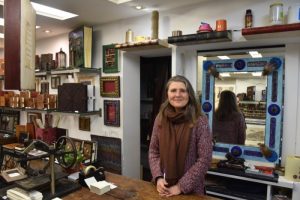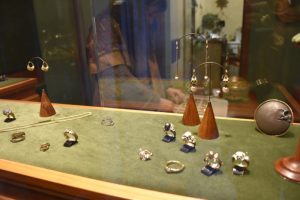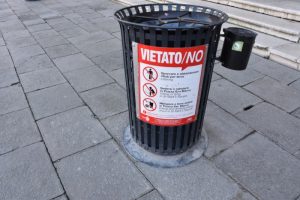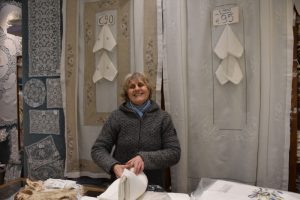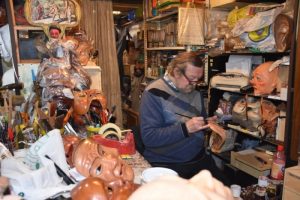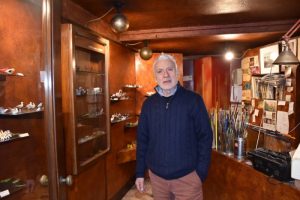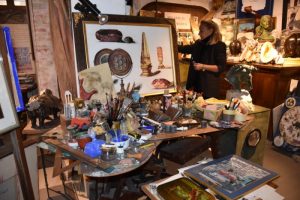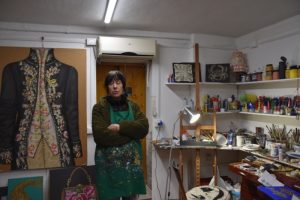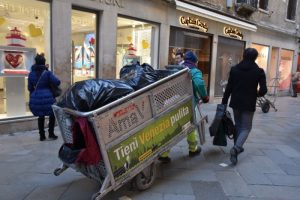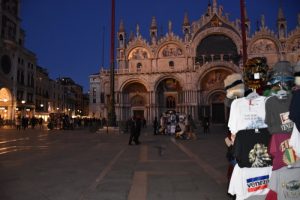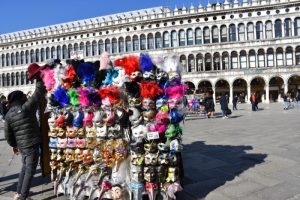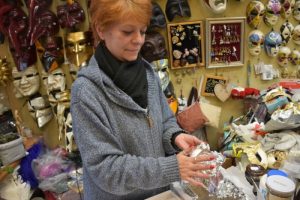“The only way to care for Venice as she deserves it is to give her a chance to touch you often – to linger and remain and return.”
Italian Hours/Henry James
Venice is, to a majority of us, one of humanity’s most seductive achievements. Not just a beautiful city on water but an entity escaped from the ferment of our imagination, possessed of an undefinable and taunting charm. At best, it offers us a unique sense of space, and of a silence within us that resounds even in the midst of a crowd. The city is quick to respond to an individual’s love. But such give and take with the visitor suffers when assailed and bullied by an overbearing tourism which has, in the last ten years, been at the height of its onslaught.
When I lived in Verona from 2005 to 2009, my artist friend, Enzo and I would meet weekly In Venice. After dodging the usual bazaar of counterfeit luxury bags and belts laid out on the pavement near San Marco and the Accademia, Enzo would take me to some arcane part of Venice where the hordes dissolved and where the city seemed to become itself again.
But what if tourist numbers resume to their previous Covid level and go on increasing, how then will even such escapes be possible for anyone ?
According to a bipartite rule of fate, it seems inevitable that even our most luminous creations fall victim to irony’s dark reprisal. Venice was born as ultimate refuge to people fleeing the barbarian invasions of the Visigoths, the Huns and the Lombards between the second and sixth centuries. When their sophisticated towns along the lagoon were sacked the fugitives sought sanctum on the watery mudflats, sowing there the seeds of their fierce independence and talent for beauty. Centuries later, the new barbarian was a type of tourist, trudging the very heart of this ultimate asylum. Unlike previous tourists who had come fewer, with more time to enjoy Venice’s generous display of splendor, these invaders were ‘drive-by’ gawkers, entitled, balefully exhibitionist.
The downgrade from visitor to tourist-barbarian is akin to what former director of New York’s MMA, Philippe de Montebello, noticed in the public’s new use of great art museums. During a 2015 conversation with Jasper Sharp, adjunct curator to Vienna’s Kunsthistoriches Museum, he noted that great museums are no longer places of art for art’s sake, but rather, enjoyed like an ‘upscale mall’, a place to hang out and be part of the social and cultural zeitgeist.
The Venice we contemplate today is more or less its fifteenth century version, the culmination of the city-state’s glory. Yet, unlike the Renaissance visitor, today’s new-comer discovers Venice after viewing it on mass media or the internet, in a plethora of available images and films. Superficial as may be this virtual pre-acquaintance, it has already ‘canned’ the experience.
The case of Venice’s dire ‘touristification’ – a term become familiar to social analysts – as was experienced right up to the Covid interruption – as some of us hope, may never happen again, exemplifies a profound contradiction at the core of the tourism paradigm. The clash originates in a general and willful effort to homogenize the world even while offering it up as discovery. This paradox affects most parts of the world, except perhaps removed places like the Lyakhovsky or Chatham Islands that, for all I know, don’t yet attract droves of tourists. The travel industry relies and thrives on fast technology which both stems from and contributes to that equalizing effect on even far apart destinations. By smoothing out cultural differences between countries, even while emitting the siren call of exoticism through marketing, industrialized tourism denies a traveler’s primary right to explore another culture. Virtual knowledge of a destination, standard infrastructures found on location, along with the inbuilt reassurance that all is much as it is back home for essentials, erode one of the very reasons for traveling.
Recent statistics for Venice have shown an unbalanced ratio between visited and visitor. 38 million tourists to Venice had been predicted for 2025 before the Covid crisis; the city had already seen some 120 000 tourists on the worst days, the majority of them, day-trippers.
The world flocked to see an agonizingly beautiful urban freak, a stage set that roused a peculiar emotion combining wistfulness and relish. The ‘touristification’ phenomenon devoured the city’s very substance, leaving a mere shell of what, by dint of a passionate self-sufficiency and ingenuity for over a thousand years, had come to be.
In 1987, the newly acquired status of UNESCO World Heritage, internationally broadcasting Venice’s fragile beauty, stimulated tourism dramatically. It wasn’t long before the financial benefits to the city’s preservation were overcome by ‘ugly tourism’, (an expression coined by Jamaica Kincaid in The ugly tourist. Previews of over-tourism had occurred on May 3rd 1987, named ‘Black Sunday’ , tourist numbers swelling to 150 000; and again, on July 15th 1989, 200 000 tourists had swarmed the city to attend a Rock concert (A traveler’s history of Venice).
Venice had come to be mistaken for a Renaissance fun-fair.
Yet it was once a dynamic and youthful place of great opportunity. Tourism, or some equivalent thereof, took place there by the twelfth century; It was, however, of a different sort from modern tourism: merchants, pilgrims, aristocrats – unlike the new mordi-fuggi (bite and run) pre-Covid day-trippers – were often introduced to Venetian society by business or personal contacts. In her article Venice has its own ‘Airbnb problem during the Renaissance. Here’s how it coped, Rosa Salzberg notes: “Indeed in Renaissance Venice, a huge influx of foreigners fueled the rise of a large informal lodging sector, which was difficult to tax and regulate and had a major impact on the whole community.” Often residing in a family’s private quarters, foreigners saw Venetian life firsthand, and unlike tourists in a hotel or Bed and Breakfast today, stayed longer. During the Renaissance, the international influx was drawn to Venice’s innovativeness in manufacturing, printing, scientific research, and to the overall high quality of its artistic and intellectual fermentation and output. The University of Padua (Padua, being part of the greater city-state of Venice) had the reputation across Europe of being more open to scientific experimentation than elsewhere, and attracted students from a variety of backgrounds. In the sixteenth century, the twenty-four year old Belgian surgeon Andreas Vesalius, taught anatomy by direct observation of the human body, while elsewhere in Europe, more stringent governance made such conditions hard to find. From its inception in the thirteenth century until the eighteenth century, the university boasted renowned professors such as Galileo and Copernicus, as well as the first woman holding a doctorate in Europe: philosopher Elena Cornaro Piscopia; not least, it had the student Giacomo Casanova, too often (like Venice itself) known better for his frivolous side than for his intellectual distinction. The ‘Grand tour’ of Europe, enjoyed mainly by upper class individuals, began in the sixteenth century, but extending into the nineteenth century, adopted that century’s lyrical construct of a saturnine Venice.
Back in the fifteenth century, Philippe de Commynes, French Ambassador to Venice, wrote: “ I have never seen a city so triumphant.” The shift is indeed striking from Venice’s image as a vigorous, forward-looking city, to one of prolonged agony. One might argue, however, that the transitional eighteenth century showed less the symptoms of early decay, as often stated, and rather more evidence of Venice’s usual audacity and resourcefulness, giving itself the means to survive until the loss of independence in 1797. It reinvented its economy by exploiting its festive inclination with five month long carnivals, an unparalleled abundance of music and opera (Monteverdi,Vivaldi, Gabrieli, Farinelli), theater( Goldoni, Gozzi), art( Guardi, Canaletto, Tiepolo…), the ridotti (gambling halls). All of this created a financial boon. In 1785, the German historian Johann Wilhelm von Archenholz, wrote how the government had eased regulations to stimulate the economy; receiving, in return, sizable taxes from gambling and prostitution. For even Venetian prostitution, (10 000 prostitutes in the seventeenth century) was considered superior to elsewhere. Typical of the city’s idiosyncratic character, all of this took place in a Venice crammed with enough holy relics to almost rival the Vatican( Holy Blood, pieces of Holy Cross, relics of Saint Theodore, Saint Mark…etc).
The mood of excruciating nostalgia for which people have more recently trooped to Venice right until the virus interruption, found its legitimacy in the genuine despondency of economic ruin after the loss of independence. The American Consul William Dean Howells described ‘a forlorn Venice’ in 1861-62 where even local aristocrats:”…lead for the most part a life of listless seclusion..”. It is estimated that in 1849 one third of the Venetian population was reduced to poverty, a quarter to rock-bottom indigence. Believed to be on its last legs, unable to restore its ‘joie de vivre’, Venice proved irresistible to nineteenth century poets and other literati become promoters of a dying Venice. At sunset, the many windowed buildings, once, a glittering reflection of a fearless Venice, were now eerily and perennially veiled by the wintry mist of a lyrical necrophilia enamored with the doomed city. In his eulogistic Ode to Venice, Byron sums it up: ” Of agony! That centuries should reap no mellower harvest! Thirteen hundred years of wealth and glory turned to dust and tears”.
Though the Russian writer Anton Chekhov still felt the power of Venice in 1891, commenting to his sister that:” Such houses and churches can only be built by people of immense artistic and musical taste and endowed with a lion-like temperament”, the French politician, Maurice Barres, around the same time, felt the deleterious sorcery of the city, describing it as a ‘poison’, a ’ fever’, seeing its agony as a main lure :”…. Cette agonie prolongée, voila le charme le plus fort de Venise pour me seduire” (that protracted agony, that’s for me the most powerful and seductive charm of Venice); or again, comparing it to a woman: ”Desespoir d’une beaute qui s’en va vers la mort. Est-ce le chant d’une vieille complice ou d’une vierge sacrifiée?» (Despair of a beauty destined to die. Is it the song of an old accomplice or that of a sacrificial virgin?) By linking Barres’ question to the recent ravages of touristification, would it be far-fetched to see the latter phenomenon as a kind of immolation or neutralizing of beauty in a time that no longer values it except as entertainment bought and sold?
When visiting his friend Byron, the Irish poet Thomas Moore, described Venice in terms of terror:”…the thousand ingredients of mystery and terror that are here at every turn.” An interpretation that was reformulated by Nicolas Roeg’s 1973 movie ‘Don’t Look Now’, and more recently by so-called dark or Thana-tourism seeking to exploit supposed haunted places in Venice like Poveglia Island, palaces Mastelli and Ca’Dario.
The type of tourist Venetians call mordi-fuggi ( four out of five tourists to Venice), according to Julia Buckley in The Tourist nobody wants, comes to get a ‘quick fix’ in that time capsule of Venice, purveyor of moods, rather than to a city of long and complex history.
Isolated from the ‘real’ world by water, in its titillating sfumato of past arrogance, opulence and carnality, the city may give rise, in today’s mood of relentless levelling, to the feeling that Venice ‘ had it coming’. In this perspective, the familiar qualification of a ‘sinking Venice’ provides tourists with their shot of dark romance and maybe also a vague sense of moral retribution.
For the approximately 50 000 remaining Venetian residents, ( the population peaked in 1951 at 174,805 residents), the ‘ugly tourist’ before Covid, was embodied by the day-tripper. Seen as disowning Venetians of their streets, the DT had in fact replaced them with a noisy, littering, unduly frugal, carelessly dressed mob.
From their shops artisans witnessed the change. Wood turners, mask-makers, paper and leather craftsmen, decorative artists, jewelers, some glass-makers, still work on the premises of their small shops, either visible to the passerby, or hidden in a separate rear space. In a room behind his tiny shop, in the central sestiere ( district) of San Marco , Sig. Cipolato creates exquisite and unique jewelry alongside his daughter. Characteristically, the work space is larger than the sales area, though sometimes the two blend almost seamlessly. Spaces are often tiny. Acceptable workplace rents hover between 800 and 1700 euros while residential rents – if artisans live in the city – vary from 2000 to 4000 euros a month: 40% to 60% more than on the mainland. More fortunate artists-craftsmen like Siga. Gigi Bon own their space in the center of town. Every inch of room is typically packed with tools, work completed and unfinished, resulting in a mesmerizing rendition of an Ali Baba cave. Profoundly attached to a refined and imaginative Venice – like most Venetian artisans – Siga. Bon resents the horde-like tourism she has seen in the last ten to fifteen years. She sees herself as a last bastion between the city’s original know-how and the symbiotic implantation of larger and impersonal stores of world-famous luxury brands.
Maria‘s lace store is ideally situated, near the Rialto, but her line of work is also menaced. The island of Burano has seen a decline in family apprenticeship; lace-making may die out. To preserve traditional techniques and patterns, Maria buys up all the old Burano lace she can find.
Carnival mask-making, for its part, is rivalled by Chinese manufacturing, mainly in Padua and in Prato, Tuscany.
But artisans mainly reproach their government for a lack of effort to help them remain in the city. Reasons of discontent include a rental market hyped by tourism, a high and increasingly complex IRPEF ( Imposto sul Reditto delle persone fisiche) fiscal system for Venetians, taxing them on money not yet earned and requiring the purchase of expensive equipment for a mandatory receipt form. Such treatment seems unjust when compared to how are treated new foreign businesses with ready cash ( the source of which remains often dubious) . Chinese businesses, and more recently Bangladeshi, benefit from a five year reprieve during which period, they pay only a 12% tax (versus 70% for Venetians). Some beneficiaries have found a way to extend the period of their reprieve by making a deal with other foreign businesses implanted in the area. The unfair competition leads to a decline in the quality of Venetian products sold to tourists.
“We are more artisan than salesmen” like to say Venetian artisans, “the relation between us and the client must be mutually appreciative and personal.” New customers are expected to return, creating a bond between craftsman and client.
One rilegatore (bookbinder) near San Marco Basilica said that when the acqua alta slowed the flow of tourists to Venice, the city’s emptiness felt menacing, because it revealed the full scope of Venice’s financial dependence on tourism. (Until Covid, tourism represented some 70% of the economy). A precariousness, further illustrated by Manuela Brunello, whose small studio – where she both paints and sells her decorative creations – depends almost entirely on the passage of tourists going to Palazzo Grassi’s well-publicized exhibitions (Cartier-Bresson was about to open at the time).
Despite daily frustrations, those artisans with more frequent contact with tourists were those most critical of a recent overall inelegance of tourism, unworthy of Venice. Many expressed a nostalgia for a time of a more educated tourism as opposed to the roughly minted ‘low-cost’ tourist of recent years. They preferred fewer and longer-staying travelers: too many tourists seemed to think that Venice was a smash-hit in which residents acted as stage extras, and they thought that the government did little to dispel that impression. Just days before the lockdown, the artisans interviewed, almost unanimously expressed a willingness to earn less money if a type of tourism disappeared altogether from Venice and local government made life easier for them.
“Mass tourism is a stupid animal, individuals, rich or poor, are fine”, commented one craftsman, wishing to dissipate the impression that he had a grudge against trippers of more modest means.
A few craftsmen sought to make their own improvements in dealing with tourism. The Foundry Valese, for one, invented a hybrid activity pairing routine business with organized tourist visits to the foundry. Such initiatives have been found to diffuse a perfidiously superficial image of Venice.
One may wonder, therefore, whether the Confederation for artisans of Venice, (Confartigianato Imprese Venezia) does enough for Venetian artisanship. Do they adhere to their statement that its presence is vital to keep the city alive? (“Botteghe e laboratory constituivano parte integrante del tessuto urbano.”/ Boutiques and workshops constitute an integral part of the urban fabric)
In 1976, 2,207 listed artisans shrank to 1,087 in 2017. In the last twenty-five years Venice’s historical core lost some 35% of its artisanship. Artisans providing common services for Venetian residents, ( non-touristic, pertaining to the category Artigianato di servizio alla demanda interna), became fewer in response to fewer permanent residents in the city and a higher cost of living. Consequently, repair services are now hard to come by in the city. The other two categories: Artigianato di servizio all patrimonio immobiliare: renovation of buildings for touristic purposes, and artigianato artistico e di servizio alla demanda turistica, being directly involved in the tourist industry, do better, even though they have to compete with the sale of paccottiglia (cheap touristic trinkets).
The Ariffaraffa Report of the Confartigianato Imprese Venezia confirms the impact of Chinese presence on Venice, in a chart showing the ‘new Silk Roads’ from China to Europe; yet does not specify the socio-cultural inconveniences and pressures imposed upon artisans and Venetians at large (grievances include noise and smelly cooking at odd hours, unacceptable civic behavior).
The combination of recently introduced alien and offensive behavior and the ‘dumbing-down’ effect of an overbearing tourism had Venetians wondering whether things had not gone too far. After all, when an urban jewel like Venice is forced to stick signs on the garbage cans to insure that litter is thrown inside and not beside (75 tons of trash daily before Covid, equivalent to a yearly spending of 44.8 million euros for removal and the repair of collateral damage), when it sees parents letting their child ride a very ancient and worn-out marble lion beside San Marco Basilica as if it were a coin-operated ride at a supermarket, when it has to remind people in bathing suits wandering the streets (calli), diving into canals, and opening iceboxes and picnicking on the steps of the Piazza’s Procuratie, that they are in an urban setting, it seems like a point of no return. In a desperate attempt to salvage some dignity and grace, Venice had recently resorted to ‘decorum angels’ who gently fined visitors 25 to 500 euros for ‘ugly tourist’ behaviour.
Between 1990-2011, the debarking of tourists from ships of up to 96000 gross tonnage, ominously dwarfing the Piazzetta like ‘Transformers’, as they passed through the Basin San Marco, was yet another brutal attack on the city. (By 2021, ships of over 55000 GT will no longer be allowed through the Basin).
But just how much improvement to such an inconceivable use of the city can more regulations and fines really achieve, if tourists in this most exquisite city, can’t figure it out on their own? As pointed out by Anna Pollock in her 2018 article Six reasons why mass tourism is unsustainable too many tourists ‘do’ places, out of a kind of media-induced FOMO-YOLO frenzy ( the by now well known ‘Fear Of Missing Out’ and ‘You Only Live Once’).
If tourists return to Venice as before Covid, and still more numerous, one might have to surrender to the view expressed by zoologist Desmond Morris: that humanity has indeed become an infestation that so-called alternate tourisms, mere bylines of mass tourism, will never solve.
Nonetheless, plans to reform tourism in Venice have been put forward. Circumventing the politically incorrect criticism of mass tourism’s aesthetic and cultural degradation of the city, proposals concentrated on safety concerns. In such a perspective, no more than 34,120 tourists a day in town were considered safe, specifically in the well-trodden area between Rialto and San Marco. A 64% reduction to the free-for-all crowding one had seen until recently in historical Venice.
The project proposes three stages:
- a) The enforcement by Zona Traffico Limitato of day-tripper registration (DT numbers swelling at times to 90 000 a day), a limit on the size of large groups, and on the number of buses, boats, ships in circulation.
- b) Over five years, a mandatory registration to enter the city, possibly with physical check gates at the train station and at Piazzale Roma car park, and a small entrance tax.
- c) An optional third stage over five years, if the second stage fails, would require buying and showing an entrance pass. Different versions of this pass to mitigate and improve tourist flow have been suggested, in descending order of preference:
Revolution ZTL: a three euros tax on day-trippers with vouchers encouraging day-trippers to become over-nighters.
Ven-us: regulating companies that bring in large groups of day-trippers, with tax benefits to real-estate owners renting to residents.
Venezia Libera: a free but mandatory reservation to enter the city.
Marco Pass: a limited access to San Marco.
Pass4Venice: an entry to the city of an amount determined by demand.
Venice, called La Serenissima, La Dominante, reminds one of a being whose exceptional beauty has made people blind to other qualities of intellect and creativity which are intrinsic to the city’s appearance, despite the evidence over the course of centuries; this inability has distorted the outlook of the average Venice tourist. Is it illusory then, to hope that the gross commercial misuse of Venice in the last twenty years might be denounced with something of the same righteous ardor that feminism has recently applied to cases of human abuse?
Doubtless, a practical strategy has to be found to deal with tourism’s physical pressure on Venice if it was to return as before. Some tourism professionals evoke the solution of virtual tourism, when technology satisfactorily ‘replaces’ the original location by way of a FIVR (Fully Immersive Virtual Reality); an experience that would definitely deprive the virtual traveler of the charm of the unexpected: those irregularities insuring the chemistry between person and place.
In the meantime, steps might be taken on a personal level, to lessen the horrors of mass tourism. If elegance and beauty were once more valued, rather than misrepresented as elitist, (an oddly un-egalitarian approach when considered closely), individual measures in that direction might be adopted with enthusiasm: “We’ve lost our appetite for anything so dull as refinement….It doesn’t seem to be a quality we value anymore, but in ignoring those things that might make us more graceful o evenly tempered, we have started to seem a bit brutish.” (In search of an elegant man) Far from being the systematic outcome of financial privilege, personal elegance requires no surplus of money. Indeed, a limited budget may even improve results. Dress may also have an influence on the wearer’s composure and manners and beget higher consideration between visitor and visited.
The visitor need not feel rejected by a Venice embalmed in unblemished beauty like Tadzio’s marmoreal face in the film Death in Venice. The city too, has its imperfections. Were Venice considered as a living city, the average tourist might realize how much he could improve on his experience there.
Understanding Venice as a multi-facetted city inhabited by active people, rather than as a film-set, has an immediate and positive effect on relations between tourists and locals, elevating them above what Benjamin Schwarz defines as:” …the ever-widening infection of social relations by market values. That development, whether good or ill, indisputably makes for blunter and more crudely utilitarian manners.” (The Rise and fall of charm in American men). Woefully used to dealing with tourists possessed of that ‘canned’ sense of Venice, Venetians are quick to warm to those who demonstrate more personal interest. Such was the case, recently, during my fortuitous encounter with a charming English couple in an antiques shop on a main drag of sestiere San Marco. A good half hour of conversation in combined English and Italian between the shop owner, the couple and myself about this and that, made us friends for life. At last, tearing away from each other’s society , we vowed to meet again soon in Venice. Evidently, all memory of the ‘ugly tourist’ had been erased from the shopkeeper’s mind.
This brings me to a delicate, though essential question: must a tourist deserve the place he visits? The suggestion defies the rampant idea that everything is owed and owned by the travel bucket-lister as a matter of course. The notion of individual experience in an iconic place like Venice is often dismissed by the must-do list of a ‘culture zoo’ view of Europe, as Rick Steves puts it (The Ugly Tourist and how not to be one); in which case, visiting key sights reaffirms a sense of place and mood previously processed. In an impersonal ritual, a traveler then seeks status affirmation, gaining the social distinction of having been to Venice. In the comment section to Annabel Fenwick Elliott’s 2020 article: When this is all over, it’s time to scrap the travel bucket list you think you want, one person describes a situation where Venice is no more than a prop for a sort of vanity tourism: “Venice in July, it was like worldwarz. What struck me was not just the hordes that made walking through the streets almost impossible, but how these patently oblivious millennial ‘bucket listers’ would take a photo of a site on their iphones and then walk away staring at the photo and grinning inanely.”
Yet even greater responsibility must lie with Venice, to redefine itself and the very nature of its tourism. In contrast to the stereotype of a ‘sinking Venice’ it will have to project the image of a vigorous city relying on other assets than those recently over-exploited by tourism, in order to continue attracting international attention and re-boot its economy.
Knowing something of the deep pride and affection Venetians have for their city, I, for one, have never believed that Venice would give up the ghost. Resident architect, Jana Revedin, reminds us, with informed optimism, that Venice has always been resilient and adaptable throughout its history: “ Depuis une douzaine d’années, un tourisme de culture et de nature s’est réinstallé, exactement comme il y a 100 ans. Au cours des années 1920, après la Grande Guerre dévastatrice et la grippe espagnole, un petit groupe de visionnaires a réinventé cette ville dépeuplée et appauvrie. On a inventé les festivals des arts nouveaux, film, dance, théâtre expérimental et on a développé le Lido comme « île nature », qu’on découvrait par la nage, la rame, le golf, l’aviation sportive. Aujourd’hui, la Biennale, les fondations d’art et de culture, les bio-agritourismes sur les îles de la lagune attirent à nouveau cet autre tourisme» (Je vous parle de Venise, la ville la plus resiliente du monde) [1]
As President of the new international Biennale of art in 1932, Count Volpi di Misurata officially re-launched Venice as an international center for the arts, including a poetry convention, a theater season and the first international film festival on the Lido the same year. Traditional Venetian festivities picked up again. The rich and royal attended lavish parties in the city; art collectors like Peggy Guggenheim settled there. After the 1966 flood and UNESCO’s international appeal, money flowed in from all sides to restore the city. The whole of Venice became a restoration laboratory, using the newest technology.
Today, the city is endowed with major institutions devoted to the arts and sciences
(University of Ca’Foscari, Accademia di Belli Arti di Venezia, Conservatorio di Musica Benedetto Marcello, ISMAR[2], CMCC[3], museums (45), theaters (7), some fourteen cultural foundations), and many religious centers of diverse denominations. Venice has not lost, therefore, the assets which made it for centuries a cultural and intellectual hotbed and nexus between west and east. If anything, it has added features to its mission as such.
Ideally, Venice will step boldly into the future, putting forward that traditional vocation. This will require a radical correction of its image as a romantic theme park enslaved by the tourism industry, and a return to embodying La Dominante. Though it would be fatuous and impossible for the city to renounce tourism, a thriving cultural and scientific Venice could rein it in as a complementary rather than as a principal asset, as suggested by Rossana Galdini: “ …. It is to recognize tourism as a major force in community development, a force that must be carefully planned and managed taking into account the principle of sustainability.” (Tourism and the city: opportunity for regeneration).
If Venice is to continue being an urban paragon to most of us it must be admired and loved for more than its looks.
Stephanie V Sears/copyright 2020
[1] “In the last twelve years, a new cultural and nature tourism has returned, exactly like a hundred years ago. During the 1920s after World War One and the devastating Spanish Flu, a small group of visionaries reinvented this deserted and impoverished city. Festivals for the new arts were created, film, dance, experimental theater, and the Lido became a ‘nature island’ reached by swimming and rowing, and people visited to play golf and for leisure aviation. Today, the Biennale, the arts and culture foundations, bio-agritourism on the outer lagoon islands attract another kind of tourism.”
[2] Istituto di Scienze Marine
[3] Euro-Mediterranean Center on Climate Change
Some bibliographical sources
- England und Italien/ Johann Wilhelm von Arenholz/1787
- Italian Hours/Henry James/1909
- Venice diary/Anton Chekov/1891
- Memoirs, journal and correspondence of Thomas Moore/ volume viii/1819
- The complete travel books of William Dean Howells/2015
- Amore et Dolori Sacrum: La mort de Venise /Maurice Barre/1903
- Venice has its own ‘Airbnb problem’ during the Renaissance- here’s how it coped /Rosa Salzberg/ The Conversation/March 14, 2019
- Venice/Christopher Hibbert/1989
- A traveller’s history of Venice/ Peter Mentzel/ 2005
- The genius of Venice/Roger Crowley/The Smithsonian magazine/October2015
- The hinge of Europe 1081-1797/ William H. McNeil/ University of Chicago/1974
- No vulgar hotel: the desire and pursuit of Venice/Judith Martin/2007
- Tourism in early modern Venice/Vanderbilt Historical Review/November 2015
- Preserving the world’s great cities/Anthony M. Tang/ Clarkson Potter/2001
- World heritage and tourism in a changing climate/UNESDOC/2016
- Venice became the front line in the battle against overtourism/ CNN Travel/June 2019
- Sinking city: how Venice is managing Europe’s worst tourism crisis/ Paula Hardy/The Guardian/ April 2019
- Six reasons why mass tourism is unsustainable/ Anna Pollock/ The Guardian/ August 2018
- The tourist nobody wants/ Julia Buckley/CNNTravel/November 2019
- The Aesthetic (design) orientated customer in tourism – implications for product development/Birgit Pikkemaat and Klaus Weiermair/Center for Tourism and Service Economics, Department for General and Tourism Management, University of Innsbruck/ October 2011
- The Ugly Tourist/Jamaica Kincaid/Harper’s Bazaar/1988
- The ugly tourist and how not to be one/Rick Steves/ Europe Blog
- The good, the bad, the ugly: tourist perception on interactions with personalized content/ Volchek, Buhalis, Law, Song/ February 2019/ Review of tourism research 16(2/3)
- Tourism and the city: opportunity for regeneration/Rossana Galdini/Tourismos/ November 2007
- Je vous parle de Venise, la ville la plus resiliente du monde/ Jana Revedin/ Immoweek/2020
- Safe and sustainable tourism: managing Venice’s millions of visitors/Connor Jr, Hanna, van Rensselaer, Wingerter/Worcester Polytechnic Institute/2015
- The naked ape/Desmond Morris/1967
- Why the world fears beauty/Dusty Gates/ Crisis Magazine/June 2016
- What does the demise of elegance say about us?/Dena Kouremetis/Psychology Today/2019
- The rise and fall of charm in American men/Benjamin Schwarz/The Atlantic/June 2013
- In search of an elegant man/Joe Ellison/Financial Times/January2019
- Elitism is a problem/Connor Wood/Orbiter/ 2018
- Elitism for all/Peter Aspden/Financial Times/2005
- When this is all over, it’s time to scrap the travel bucket list you think you want/Annabel Fenwick Elliott/March 2020
- Virtual reality in tourism: a state of the art review/Beck, Rainoldi, Egger/Tourism Review/2019
- Is virtual reality travel here to stay?/ Malavika Kumar/ Travel Earth/2020
- Philippe de Montebello/Jasper Sharp/2015
- https://www.youtube.com/watch?v=OCTN9Wkbs7Y&list=PLDoWx4K015JbGiDQ-HmL2qf0OmqYHJFcE&index=16
Stephanie V Sears © 2020.

